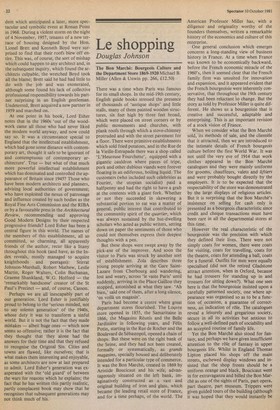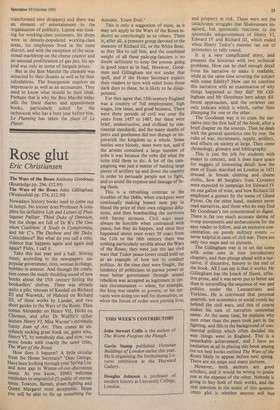Le shopping
Douglas Johnson
The Bon Marche: Bourgeois Culture and the Department Store 1869-1920 Michael B. Miller (Allen & Unwin pp. 266, £12.50) There was a time when Paris was famous for its small shops. In the mid-I9th century, English guide books stressed the presence of thousands of 'antique shops' and little stalls, many of them painted wooden structures, six feet high by three feet broad, which were placed on street corners or by public monuments and churches, with plank roofs through which a stove-chimney protruded and with the street pavement for a floor. There were primitive establishments which sold fried potatoes, and in the Rue de la Vieille-Estrapade there was a shop called `L'Heureuse Fourchette', equipped with a gigantic cauldron where pieces of tripe, pork and other dubious viands were forever floating in an odiferous, boiling liquid. The customers (who included such celebrities as Fourier, the utopian socialist) paid a halfpenny and had the right to have a grab at the contents with a giant fork. Whether or not they succeeded in skewering a substantial portion to eat was a matter of general, public interest that contributed to the community spirit of the quartier, which was always sustained by the hut-dwelling scholars who acted as public writers, setting down on paper the sentiments of those who could not themselves express their deepest thoughts with a pen.
But these shops were swept away by the pick-axe of the improver. And soon the visitor to Paris was struck by another sort of establishment. Zola describes three young people arriving at the Gare SaintLazare from Cherbourg and wandering, lost and weary, across 'le vaste Paris' until suddenly, arriving in the Place Gaillon they stopped, astonished at what they saw. `Ah bien,' said one of them, after a long silence, 'en voila un magasin'.
Paris had become a centre where great department stores flourished. The Louvre store opened in 1855, the Samaritaine in 1866, the Magasins Reunis and the Belle Jardinière in following years, and Felix Potin, starting in the Rue de Rocher and the Boulevard de Sebastopol, opened a chain of shops. But these were on the right bank of the Seine, and they had not been created, formally or systematically, as grands magasins, specially housed and deliberately intended for a particular type of commerce. It was the Bon Marche, created in 1869 by Aristide Boucicaut and his wife, advantageously situated on the left bank, imaginatively constructed as a vast and original building of iron and glass, which became the leading retail store of France, and for a time perhaps, of the world. The American Professor Miller has, with a diligence and originality worthy of the founders themselves, written a remarkable history of the economics and culture of this enterprise.
One general conclusion which emerges concerns a long-standing view of business history in France. At a time when France was known to be economically backward, before the French economic miracle of the 1960's, then it seemed clear that the French family firm was unsuited for innovation and expansion, and it appeared evident that the French bourgeoisie were inherently conservative, that throughout the 19th century they had been reluctant to change. But the story as told by Professor Miller is quite different. He shows us a bourgeoisie that is creative and successful, adaptable and enterprising. This is an important revision of a stock vision of France.
When we consider what the Bon Marche sold, its methods of sale, and the clientele that it attracted, then we are introduced to the intimate details of French bourgeois culture before the first World War. It was not until the very eve of 1914 that work clothes appeared in the Bon Marche catalogues and they were mainly uniforms for grooms, chauffeurs, valets and hiders and were probably bought directly by the employers. It is to be expected that the respectability of the store was demonstrated by the large displays of religious articles. But it is surprising that the Bon Marche's insistence on selling for cash only is presented as a bourgeois characteristic since credit and cheque transactions must have been rare in all the departmental stores at this time.
However the real characteristic of the bourgeoisie was the precision with which they defined their lives. There were not simply coats for women, there were coats for visiting, coats for travelling, coats for the theatre, coats for attending a ball, coats for a funeral. Outfits for men were equally specialised (did not the retired Gladstone attract attention, when in Oxford, because he had trousers for standing up in and trousers for sitting down?). What one sees here is that the bourgeoisie insisted upon a carefully patterned society, one where appearance was organised so as to be a function of occasion, a guarantee of correctness, an indication of role. The catalogues reveal a leisurely and gregarious society, secure in all its activities but anxious to follow a well-defined path of sociability and an accepted routine of family life.
Yet the Bon Marche also stood for fantasy, and perhaps we have given insufficient attention to the role of fantasy in upper bourgeois life. Whilst in England Thomas Lipton placed his shops off the main streets, eschewed display windows and insisted that the shop fronts should be a uniform orange and black, Boucicaut went in for extravaganza and billed the Bon Marche as one of the sights of Paris, part opera, part theatre, part museum. Trippers were given guided tours of the building (although it was hoped that they would instantly be transformed into shoppers) and there was an element of entertainment in the organisation of publicity. Lipton was looking for working-class customers, his shops were in densely-populated working-class areas, his employees lived in the same district, and with the exception of the occasional marbletop on the cheese counter and an unusual proliferation of gas jets, his appeal was only in terms of bargain prices.
But in the Bon Marche the clientele was attracted by their dreams as well as by their calculations. The bourgeoisie requires an impressario as well as an accountant. They need to know what should be their ideal. Perhaps that is why the Bon Marche today sells the finest diaries and appointment books, particularly suited for the technocrat who has a busy year before him. Le Planning has taken the place of Le Plaisir.







































 Previous page
Previous page